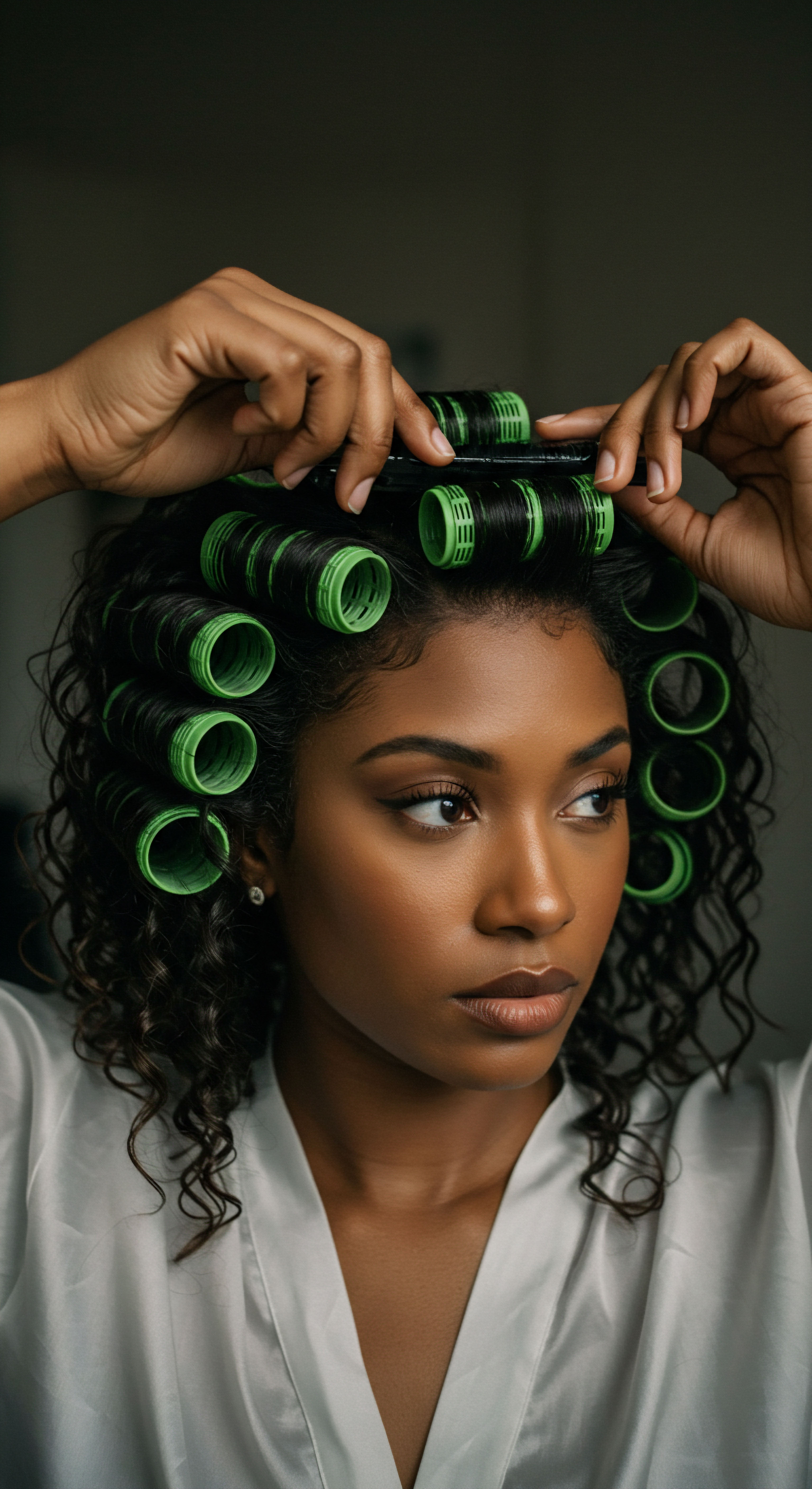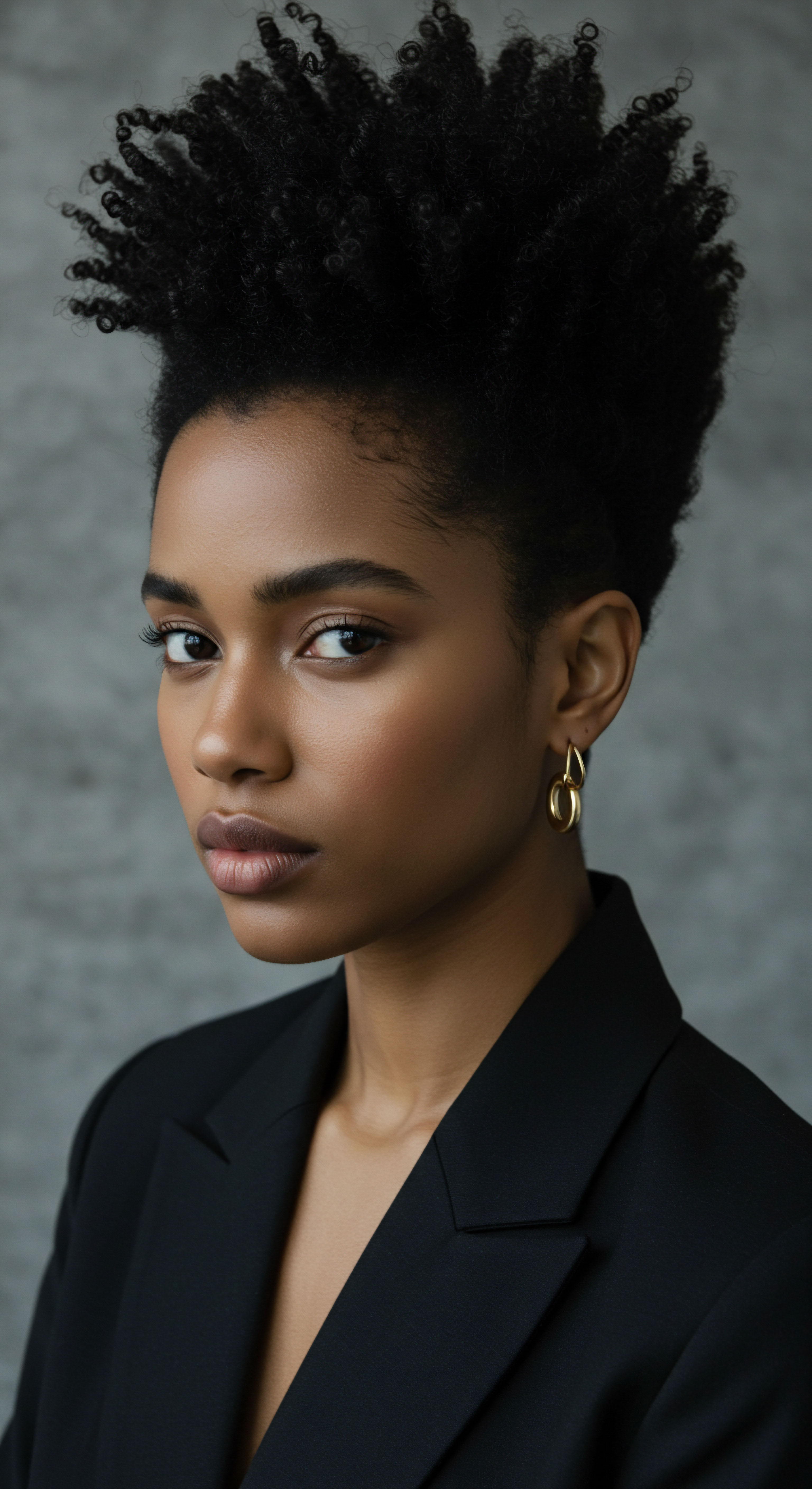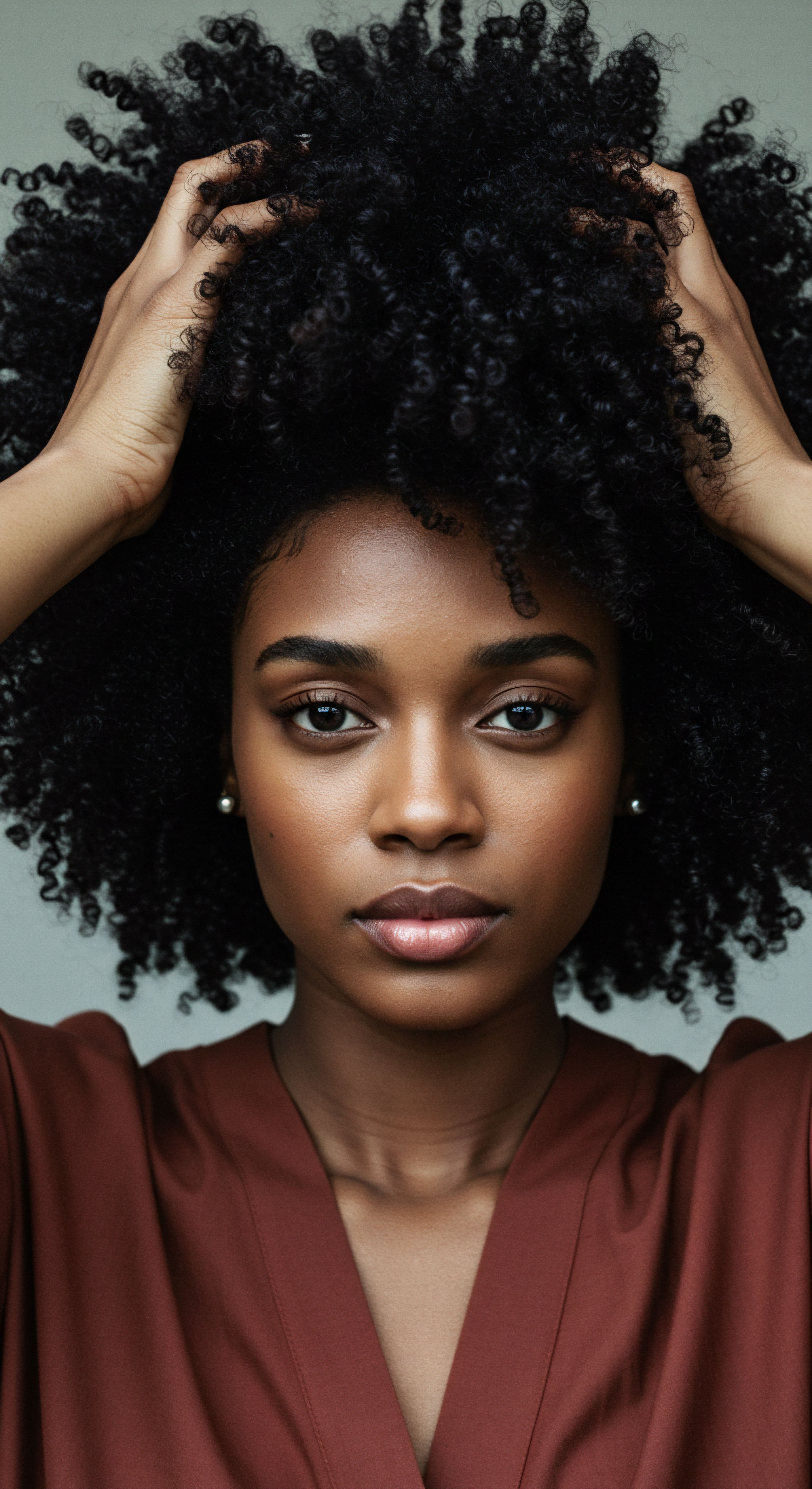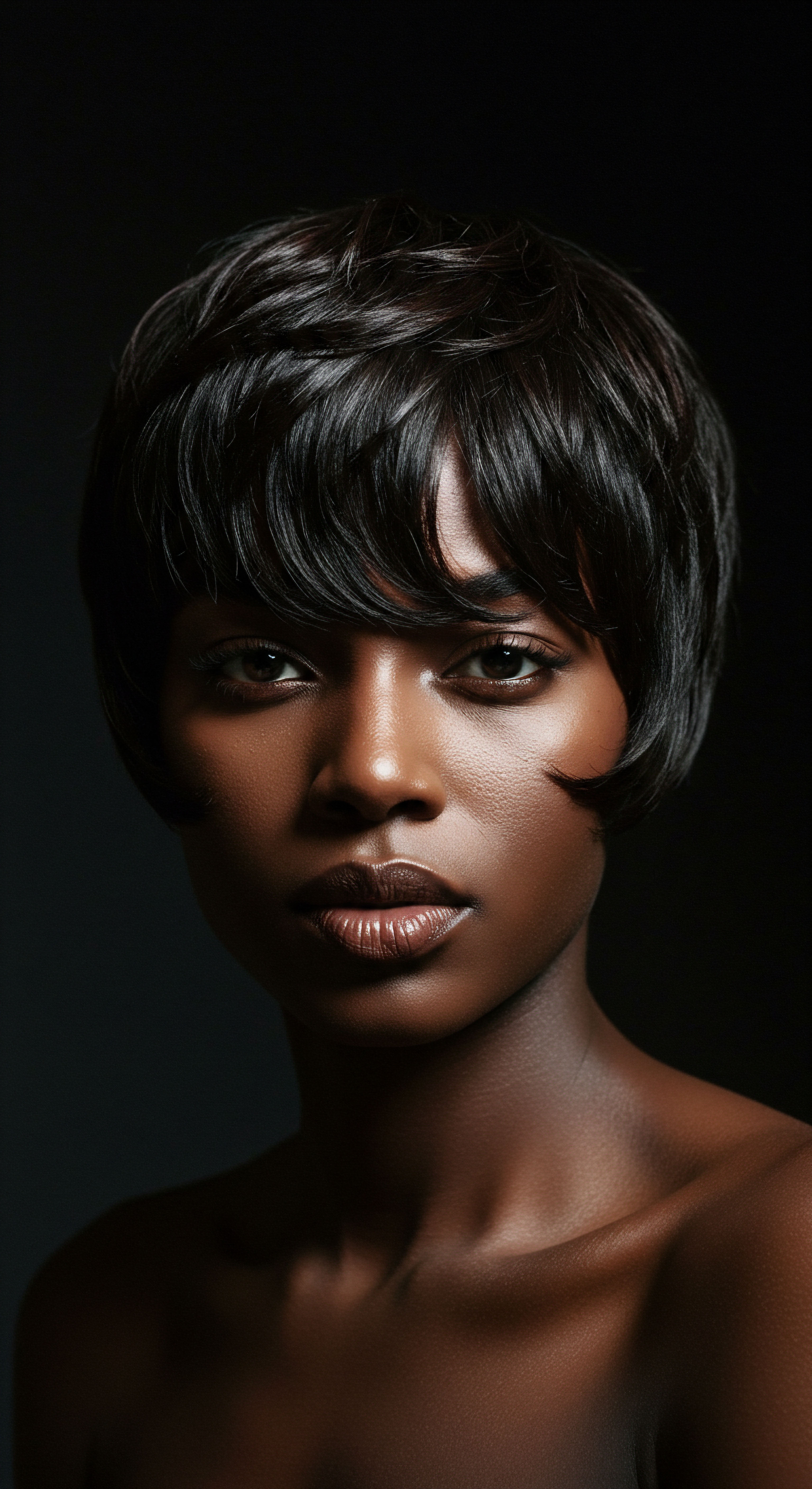
Roots
The quiet dance of our strands, how they respond to the world around us, often holds a deeper story than we realize. Beyond the inherent blueprints passed down through generations, our hair’s porosity – its capacity to absorb and retain moisture – is a dynamic attribute, shaped by the whispers of our environment and the choices we make. It is a dialogue between our individual strands and the living, breathing world, a conversation unfolding daily, sometimes subtly, sometimes with pronounced shifts. Understanding this dialogue unlocks a more intuitive, respectful approach to care, moving beyond simple surface-level observations to a deeper acquaintance with our hair’s true nature.

What is Hair Porosity and Its Core Structure?
At its fundamental level, hair porosity speaks to the state of the outermost layer of the hair shaft, the Cuticle. Picture the cuticle as a series of overlapping scales, much like shingles on a roof. When these scales lie flat and close together, hair exhibits low porosity, meaning it resists moisture entry but, once hydrated, holds onto that moisture well.
Conversely, when these scales are raised or compromised, hair becomes highly porous, readily absorbing water but just as quickly allowing it to escape. This delicate balance of the cuticle is the primary determinant of how your hair interacts with water, products, and the elements.
The hair shaft itself, a non-living structure, is primarily composed of Keratin Proteins. Beneath the protective cuticle lies the cortex, which forms the bulk of the hair and contains the majority of its protein and pigment. The integrity of these internal structures, shielded by the cuticle, is paramount to overall hair health. Damage to the cuticle, whether from external forces or internal deficiencies, directly impacts the cortex, influencing everything from elasticity to strength and, naturally, porosity.

How Does Environmental Exposure Impact Hair’s Openness?
Our hair, like our skin, faces a constant barrage from the environment. The sun, air quality, and even the water we use for cleansing contribute significantly to how open or closed our hair’s cuticle layers become. These external factors can gradually alter the hair’s structure, influencing its porosity over time.
- Solar Radiation ❉ Sunlight, particularly ultraviolet (UV) radiation, is a potent external aggressor. UV rays can degrade hair proteins, especially keratin, and lipids, leading to a loss of the hair’s natural protective layers. This degradation can cause the cuticle scales to lift, increasing the hair’s porosity. UVB radiation is particularly responsible for protein loss, while UVA contributes to color changes. The outermost lipid layer of the cuticle, known as 18-Methyl Eicosanoic Acid (18-MEA), acts as the hair’s first hydrophobic barrier. Its removal by UV exposure makes hair more susceptible to swelling and moisture loss, thus increasing porosity.
- Atmospheric Pollutants ❉ The air we breathe carries particulate matter, heavy metals, and various chemical compounds. These pollutants can cling to the hair surface and even penetrate the hair fiber, leading to oxidative stress and chemical damage to the cuticle and internal proteins. Studies indicate that while particulate matter alone might not significantly increase hair porosity, its combination with UV irradiation can substantially heighten it. This interplay creates a double burden on the hair’s structural integrity, making it more permeable.
- Water Quality ❉ The water used for washing, often overlooked, holds its own story of influence. Hard water, rich in dissolved minerals like calcium and magnesium, can deposit these salts onto the hair shaft. This mineral accumulation can lead to a rougher surface, making hair feel heavy, stiff, and prone to dryness. While direct links to permanent hair loss remain under investigation, mineral buildup can certainly hinder moisture penetration and compromise the cuticle’s smooth alignment, thereby affecting porosity.
Our hair’s porosity, its capacity to absorb and retain moisture, is not static but a dynamic attribute shaped by the environment and our choices.
These environmental dialogues highlight that porosity is not merely a genetic given but a living characteristic, continuously adapting to the world it encounters. Understanding these influences empowers us to approach hair care with a more informed, responsive touch.

Ritual
Stepping into the realm of daily hair care, we encounter the practices and products that shape our hair’s journey. Our rituals, from the simplest wash day routine to the most elaborate styling session, exert a profound influence on hair porosity. These are the hands-on engagements that either support the hair’s inherent resilience or, inadvertently, contribute to its vulnerability. The intention behind each gesture, the ingredients within each product, and the very tools we select, all play a part in the story of our hair’s moisture balance.

How Do Hair Care Practices Alter Porosity?
The mechanical and chemical forces we apply to our hair, however gentle or aggressive, leave their mark on the cuticle. Regular care, or a lack thereof, dictates the openness of these protective scales.
- Chemical Alterations ❉ Hair dyes, bleaches, relaxers, and perms are designed to alter the hair’s chemical structure, often by breaking and reforming disulfide bonds within the cortex. This process, by its very nature, lifts and compromises the cuticle, almost universally leading to increased porosity. The hair becomes more receptive to color or style changes, but also more susceptible to moisture loss and damage. Repeated chemical treatments, particularly without proper conditioning and protective measures, can severely weaken the hair, increasing its fragility and making it highly porous.
- Thermal Styling ❉ The allure of sleek straightness or bouncy curls often involves heat. Flat irons, curling wands, and even high-heat blow dryers can cause water within the hair shaft to vaporize rapidly, creating microscopic voids and lifting cuticle scales. This thermal damage can significantly increase porosity, making the hair dry, brittle, and prone to breakage. Consistent exposure to high temperatures without adequate heat protection strips the hair of its natural lipids and can denature proteins, leaving it vulnerable.
- Mechanical Manipulation ❉ Simple acts like brushing, combing, and even towel-drying can impact porosity. Aggressive detangling, especially on wet hair, can cause cuticle damage and friction. Hair is more fragile when wet, and improper mechanical handling can lead to breakage and lifted cuticles. The friction between hair fibers, particularly in textured hair, can also contribute to cuticle wear over time, gradually increasing porosity.

Do Product Ingredients and Formulations Influence Porosity?
The substances we apply to our hair, whether for cleansing, conditioning, or styling, have a direct impact on its surface and, by extension, its porosity. The chemical composition of these products interacts with the hair’s external layers.
Surfactants in Cleansers ❉ Shampoos, with their cleansing agents (surfactants), are designed to remove dirt and oils. While essential for hygiene, harsh or overly stripping surfactants can remove too much of the hair’s natural lipid barrier, leaving the cuticle exposed and potentially more open. This is particularly relevant for textured hair, which tends to be naturally drier and more prone to cuticle lifting. A gentle, sulfate-free cleanser, conversely, aims to cleanse without excessive stripping, preserving the cuticle’s integrity.
Conditioning Agents and Film-Formers ❉ Conditioners, leave-ins, and styling products often contain ingredients that help to smooth the cuticle, reduce friction, and form a protective layer on the hair shaft. Silicones, natural oils, and hydrolyzed proteins are common examples. These ingredients can temporarily seal or smooth the cuticle, reducing porosity and improving moisture retention.
For instance, some oils, like coconut oil, can even penetrate the hair shaft, reducing water sorption and helping to protect the hair from swelling. This external coating can significantly alter how the hair feels and behaves, masking underlying porosity or actively working to manage it.
Our daily hair rituals, from chemical treatments to product choices, profoundly shape the hair’s porosity, either preserving its resilience or contributing to its vulnerability.
The choices made within our daily and weekly hair care rituals are not trivial; they are active participants in the ongoing conversation about hair porosity. Conscious selection of methods and products can either exacerbate existing porosity concerns or contribute to a healthier, more balanced moisture state.

Relay
To truly comprehend the dynamic nature of hair porosity, we must venture beyond the immediate and the tangible, exploring the intricate interplay of biological nuances, environmental pressures, and cultural legacies. The story of our hair’s interaction with the world is a complex tapestry, where science and lived experience intertwine, revealing a profound interconnectedness that often goes unnoticed. It is a space where the individual strand meets the collective human experience, and where external factors sometimes challenge our very understanding of hair health.

Do Environmental Stressors and Lifestyle Choices Deeply Alter Hair Structure?
The cumulative effect of our surroundings and our way of life can profoundly impact the hair’s internal architecture and external defenses, thereby influencing its porosity. It is not simply about what we do to our hair, but also where we are, and how we live.
Consider the impact of Hard Water, a seemingly benign daily presence for many. While its effects are often discussed in terms of mineral buildup, a study published in the Indian Journal of Dermatology, Venereology, and Leprology highlighted a more profound concern. Researchers observed a statistically significant decrease in the tensile strength of hair treated with hard water, particularly in male hair samples.
This suggests that beyond superficial mineral deposits, the sustained interaction with hard water can compromise the hair’s inherent strength, making it more susceptible to damage that leads to increased porosity and breakage. This finding, while potentially controversial in its implication of a direct link to strength reduction rather than just surface effect, underscores the need to consider the subtle, long-term environmental exposures that chip away at hair integrity.
Beyond water, the invisible atmospheric elements pose a silent threat. Air pollution, containing particulate matter and volatile organic compounds, does more than just make hair feel dirty. These pollutants can induce oxidative stress on hair follicles and fibers, potentially damaging the cuticle and leading to a more porous structure. Research presented at dermatology meetings has even pointed to a decrease in proteins essential for hair growth, like beta-catenin and cyclin D1, due to pollution exposure, hinting at a systemic impact that extends beyond the hair shaft itself.
Diet and Nutrition, while often discussed in terms of overall health, are also deeply tied to hair integrity. Deficiencies in essential vitamins, minerals, and proteins can compromise the production of healthy hair, indirectly affecting its structural resilience and its ability to maintain an optimal porosity level. A well-nourished body supports a healthy scalp, which in turn provides a better foundation for robust hair growth, less prone to damage and increased porosity.

How Do Cultural Hair Practices Intersect with Porosity?
Hair care is rarely a purely scientific endeavor; it is steeped in cultural traditions, historical contexts, and personal identity. These cultural practices, often passed down through generations, can have a tangible impact on hair porosity, sometimes inadvertently, sometimes with protective wisdom.
Different ethnic hair types exhibit distinct morphological features and inherent variations in cuticle structure. For example, African hair typically has fewer cuticle layers than Asian or Caucasian hair, and its unique elliptical shape and curl pattern mean cuticle scales may not lie as flat. This inherent structural difference can contribute to a naturally higher porosity in textured hair, making it more prone to moisture loss.
Cultural styling practices, such as frequent braiding, twisting, or the use of specific heat-styling techniques, while serving aesthetic or protective purposes, can also contribute to mechanical stress on the hair. Understanding these practices within their cultural context, rather than simply labeling them as “damaging,” allows for a more nuanced approach to hair health, promoting methods that preserve hair integrity while respecting heritage.
Consider the varying frequencies of hair washing across different cultural groups. A study focusing on pediatric populations noted that Black and mixed-race children were more likely to use medicated shampoos weekly or less frequently compared to White patients. While this practice might stem from the need to preserve moisture in naturally drier hair or to avoid excessive manipulation, it can also influence product buildup and the hair’s overall interaction with its environment, potentially affecting porosity over time.
The historical use of specific natural ingredients, such as certain oils or clays, in traditional hair care rituals often reflects an intuitive understanding of hair’s needs, even if the underlying science of porosity was not explicitly known. These practices, when viewed through a modern scientific lens, can reveal valuable insights into maintaining hair health and managing porosity in diverse hair types.
Beyond the visible, environmental factors like hard water and air pollution can subtly erode hair strength, while deeply rooted cultural practices shape porosity through generations of care and styling.
The intricate interplay between our environment, our daily habits, and our cultural expressions paints a holistic picture of hair porosity. It is a reminder that hair health is not a solitary journey but one influenced by a multitude of forces, both seen and unseen, scientific and cultural.
| Factor Category Environmental Exposures |
| Specific Influences UV Radiation (sunlight) |
| Impact on Porosity Degrades proteins and lipids, lifts cuticle scales, increases porosity. |
| Factor Category Environmental Exposures |
| Specific Influences Air Pollution (particulate matter, chemicals) |
| Impact on Porosity Causes oxidative stress, damages cuticle, increases porosity, especially with UV. |
| Factor Category Environmental Exposures |
| Specific Influences Water Hardness (calcium, magnesium minerals) |
| Impact on Porosity Leads to mineral buildup, can reduce tensile strength, compromises cuticle smoothness. |
| Factor Category Chemical Treatments |
| Specific Influences Hair Dyes, Bleaches, Relaxers |
| Impact on Porosity Alters internal structure, lifts cuticle, significantly increases porosity. |
| Factor Category Thermal Styling |
| Specific Influences High Heat Styling (flat irons, curling wands) |
| Impact on Porosity Vaporizes internal moisture, lifts cuticle, causes dryness and brittleness. |
| Factor Category Mechanical Manipulation |
| Specific Influences Aggressive Brushing/Combing |
| Impact on Porosity Causes friction and physical damage to cuticle, leads to breakage. |
| Factor Category Lifestyle and Nutrition |
| Specific Influences Dietary Deficiencies |
| Impact on Porosity Compromises hair production, indirectly affects structural resilience. |
| Factor Category Product Formulation |
| Specific Influences Harsh Cleansers (stripping surfactants) |
| Impact on Porosity Removes natural lipids, leaves cuticle exposed, increases openness. |
| Factor Category Product Formulation |
| Specific Influences Conditioning Agents (silicones, oils, proteins) |
| Impact on Porosity Smooths cuticle, reduces friction, temporarily seals surface, decreases porosity. |
| Factor Category Understanding these diverse influences allows for a more tailored approach to hair care, acknowledging the many factors beyond genetics that shape hair porosity. |

Reflection
The journey through hair porosity, from its fundamental structure to the intricate dance with environment and culture, reveals a landscape far richer than simple genetics might suggest. Our hair, particularly textured hair, stands as a testament to adaptability, a canvas reflecting not only our inherited traits but also the stories of our surroundings, our practices, and our very ways of being. It is a call to observe, to listen to the subtle cues our strands offer, and to respond with informed, compassionate care. As we continue to learn, the path to truly healthy, resilient hair becomes less about rigid rules and more about a harmonious relationship, respecting its delicate balance and the myriad forces that shape its unique expression.

References
- Halal, John. Hair Structure and Chemistry Simplified. 5th ed. Cengage Learning, 2008.
- Baki, Gabriella. Introduction to Cosmetic Formulation and Technology. 2nd ed. Wiley, 2023.
- Tadros, Tharwat F. Formulations ❉ In Cosmetic and Personal Care. De Gruyter, 2015.
- Richena, M. and Rezende, C.A. “Effect of photodamage on the outermost cuticle layer of human hair.” Journal of Photochemistry and Photobiology B ❉ Biology, vol. 153, 2015, pp. 296-304.
- Ruetsch, S. B. et al. “Hair color changes and protein damage caused by ultraviolet radiation.” Journal of Photochemistry and Photobiology B ❉ Biology, vol. 74, no. 2-3, 2004, pp. 109-117.
- Alahmmed, L. M. et al. “Scanning electron microscopy study of hair shaft changes related to hardness of water.” Indian Journal of Dermatology, Venereology, and Leprology, vol. 83, no. 6, 2017, pp. 740-742.
- Lee, S. H. et al. “Effects of ultraviolet rays and particulate matter on hair porosity in damaged hair.” Journal of Cosmetic Dermatology, vol. 23, no. 6, 2024, pp. 2002-2007.
- Abel, K. and T. A. Evans. “On Hair Care Physicochemistry ❉ From Structure and Degradation to Novel Biobased Conditioning Agents.” Polymers, vol. 14, no. 23, 2022, pp. 5240.
- Randall, V. A. “Hair and its disorders.” The Institute of Trichologists, 2024.
- Gavazzoni Dias, M. F. R. “Hair Cosmetics ❉ An Overview.” International Journal of Trichology, vol. 7, no. 1, 2015, pp. 2-15.
- Al-Refai, M. et al. “To Evaluate and Compare Changes in Baseline Strength of Hairs after Treating them with Deionized Water and Hard Water and its Role in Hair Breakage.” International Journal of Trichology, vol. 9, no. 2, 2017, pp. 58-62.
- Park, J. H. et al. “Research Progress in Composition, Classification and Influencing Factors of Hair.” Asian Journal of Beauty and Cosmetology, vol. 21, no. 3, 2023, pp. 331-340.